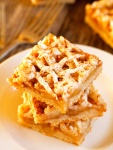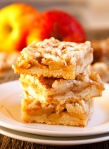
Der Pfannkuchen. German pancakes are called Pfannkuchen or Eierkuchen, depending on region. They’re thicker than French crêpes, literally pan-sized, and usually served with sweet things such as Apfelmus (apple sauce), Puderzucker (powdered sugar), regular sugar and lemon, alcoholic toppings, with cream, or fresh fruit. Fried apple rings covered by dough with sugar & cinnamon are called Apfelküchle. In Schwaben, Southerwestern Germany, sliced pancake strips (Flädle) appear in savoury broth. In some regions in the East (Berlin, Brandenburg, Sachsen) pancakes are called Eierkuchen, as “Pfannkuchen” refers to a Berliner or Krapfen there. Kaiserschmarrn, originally Austrian, is a thick caramelized pancake ripped apart into bite-size pieces with fruit or nuts, sprinkled with powdered sugar, and served with a fruity sauce.




